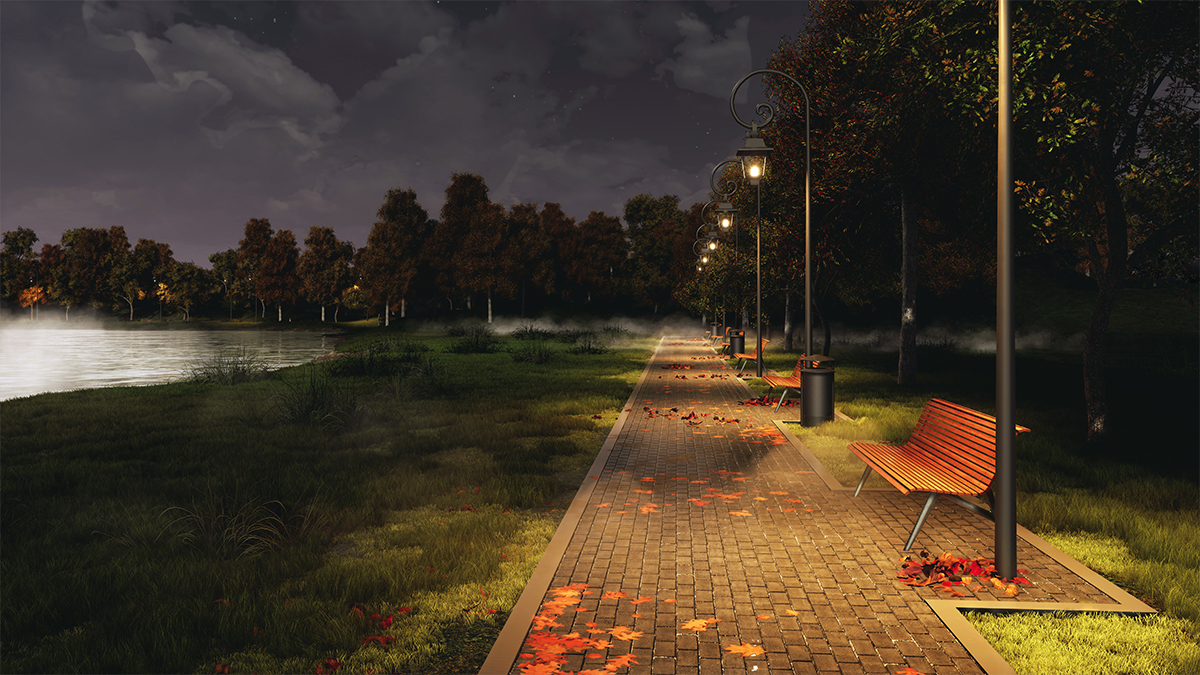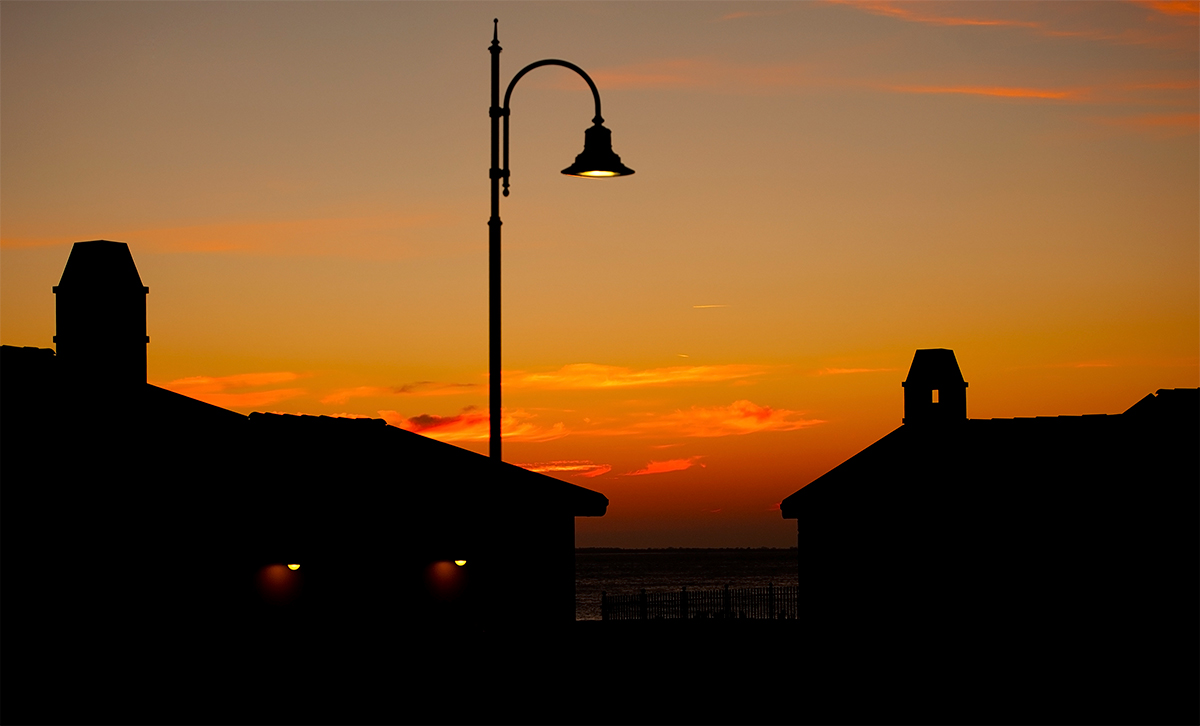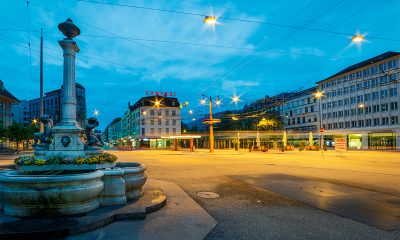An artful approach to improve nighttime functionality
Pendant street lights are human scale lighting systems that provide ambient illumination for outdoor areas and roads where pedestrians and cyclists are present. Unlike post top lights where the fixture design is dominant over the pole, pendant street lights rely on the use of mounting arms to complete the overall design statement. The hanging luminaire in combination with the arm and pole evokes a timeless, elegant aesthetic that is not as easily accomplished with other types of outdoor light fixtures. Pendant street lights are also referred to as down lighting fixtures since their optical systems are perpendicular to nadir and maintain a downward direction for all or a significant portion of the light output. The luminaires are mounted on heights of 3 m to 9 m. These graceful pendant lights are used on residential neighborhoods, commercial plazas, college campuses, urban boulevards, pedestrian walkways, bikeways, parks, and squares.
Pendant street lights are statements unto themselves
Bringing together form and function, pendant street lighting provides accurate and comfortable visibility at night of possible hazards while also adorning metropolitan avenues, town streets and residential communities with a pleasant daytime and nighttime appearance. A quality public lighting design doesn’t just make a contribution towards traffic safety and pedestrian security, it takes into account the larger environmental context with an intention to create a positive visual composition.
In urban areas, many elements might have to be integrated and interact with each other. Human scale lighting applications require light fixtures to be aesthetically compatible with their surroundings in order to organize the overall appearance of the scene into one continuous panorama. Coordinating lighting with architecture and landscape contributes to the visual theme of a community, helps maintain the visual character of a historic district, reinforces design aesthetics of commercial shared streets, and enables infusion of all the streetscape elements together into a cohesive, sensible scene.

Style and scale
The style and scale of a lighting system are critical to bringing a consistent overall character and balance to an outdoor space. With careful coordination of such elements as decorative detailing, luminaire design, fixture color and mounting height, lighting can make itself a thoughtful architectural or landscape element. Pendant street lighting is most appreciated for its classical elegance that exudes a timeless quality and never goes out of style. The luminaires come in forms of teardrops, lanterns, acorns, spheres, or are characterized by distinctive shades with a bowl, flat bowl, RLM, radial, bell, or cone design.
Arm designs which constitute a major part of the aesthetic composition can be long or short, straight or curved and can include decorative scroll, gusset and brace work or castings. The arm collection includes post top crook arms, side pole crook arms, post top swept cast arms, side pole swept cast arms, side pole S-shaped up/down cast arms, side pole neo-classic arms, side pole ribbon arms, contemporary arms (straight, swept, upsweep and uplift adjustable arms), etc.
Poles come in sharp flute, flat flute, flat flute, round, sharp flute, and octagonal square shapes. Fluted poles work very well with traditional style luminaires. Architectural poles that are clean and simple in design complement contemporary style luminaires. Transitional designs can accommodate virtually any pole and arm design.
Dimensions and visual composition of pole bases, pole shafts, arms, and luminaires should be balanced for proper scaling. Luminaires and pole bases should be roughly equal in size and volume. 4” square or round poles are usually designed with pole heights between 10’ and 13’, 5” poles should be used on heights of 14’ to 16’, and poles with diameters and square dimensions of 6” should work with heights of 17’ and taller. The lengths of arms should be 20% to 25% of the pole height so that they will not look out of scale and miss-matched. Scrolls and other decorative elements should be used with long arms in order to add mass to the pole and arm transition.
LED lighting takes everything to another level
Pendant street lighting has evolved tremendously since the advent of LED lighting. The solid state lighting technology allows holistic optimization of all lighting application efficiency (LAE) factors, which yields energy savings from optical delivery efficiency, spectral efficiency and intensity effectiveness, beyond just improvement to light source efficiency. In contrast, traditional lighting systems that use high pressure sodium (HPS), metal halide (MH), or compact fluorescent lamps have high optical loss of the lumens produced by the omni-directional lamps. Poor on/off/dim capability of these light sources makes it close to impossible to implement adaptive lighting strategies that drive further energy savings.
The savings in operating costs are compounded by reduced maintenance costs from the use of LEDs which could substantially outlast traditional light sources when they’re properly integrated into the luminaire. LED lighting also improves the quality of outdoor lighting with its excellent color rendering properties and controllability in optical distribution. Beyond these quantitative and qualitative advantages of LED lights, the LED technology platform can produce new form factors and lighting design flexibility thanks to the small source size, directional light output and solid state durability.

Technology implementation
The transition to LED lighting results in the presence of two types of LED lighting systems: lamp-based and integrated. Lamp-based LED pendant street lights are conventional lighting systems designed to accommodate LED lamps with ANSI/IEC standard bases. LED retrofit technology makes upgrading of traditional lighting technologies to LED lighting quick and painless. However, the replacement LED lamp must fit the form factor of the HID or compact fluorescent lamp for which the luminaire is designed. To work correctly within the existing electrical form factor compromises in the system design for thermal management and driver circuitry have to made due to the space constraint. As a result, LED lamps typically have a considerably shorter lifespan and lower operating efficiency compared with integrated LED systems that have the operating environment fully optimized for the LEDs.
An integrated LED pendant street light, as was just mentioned, is designed around integrating the LEDs with the thermal management system at the luminaire level. Its optical system provides direct regulation of the luminous flux from the LEDs. The design flexibility affords the luminaire the space to incorporate a high performance LED driver and lighting control devices. Absence of lamp-scale form factor restriction allows the creation of a light emitting surface (LES) that is tailored to a specific application for a higher LAE and a more effective (uniform) light distribution for area and street lighting.
Thermal management
Achieving high levels of energy efficiency, performance and reliability in LED lighting involves complex systems design. Most failure mechanisms of LEDs are temperature-dependent. Basically, the maximum allowable junction temperature of the LEDs should not be exceeded, since this can lead to irreversible lumen depreciation. A key aspect of thermal design is integrated LED street lights is to maximize the heat sink’s ability to convect heat away from the LED source by maximizing the surface area and implementing an effective aerodynamic design.
Drive current regulation
The drive current should be properly regulated to protect the LEDs against damages from high-current-induced thermal effects. The AC-powered LED driver must provide high efficiency power conversion while delivering high reliability with robust specifications for power surge, overload and extreme temperature protection. The driver usually incorporates dimming circuitry and integrates sensing devices to tailor the delivery of light to user needs and preferences through occupancy control and daylight harvesting.
Optical control
The optical system of pendant street lights provides aesthetic enhancement and control of light distribution. Traditional style luminaires extensively utilize a combination of reflector and refractor elements to eliminate uplight, provide cutoff distribution, and deliver uniform illumination. Contemporary designs often make use of lenses to produce precisely controllable optical distributions. The lumens in each of the backlight, uplight and high-angle glare subzones must comply with the BUG (Backlight, Uplight, and Glare) requirement for a specific lighting zone.
Control over environmental factors
The light engine and electrical circuits of a pendant street light must be sealed to exclude moisture, dust, contaminants and insects. The outdoor lighting application places high demands the corrosion protection performance of the metal components. The aluminum luminaire housing and the pole assembly which is in most cases fabricated from aluminum or steel are chemically pretreated to create a protective barrier that will prevent corrosion and oxidization of the metal while improving the adhesion between substrate and polyester powdercoat finish for optimal color and gloss retention.



















Loading...
New member